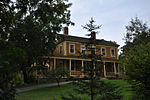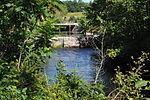North Branch Little River (Maine)
Maine river stubsRivers of Maine
The North Branch Little River is a 9.8-mile-long (15.8 km) tributary of the Little River in southern Maine. It is part of the Presumpscot River watershed, which flows to Casco Bay in the Atlantic Ocean. The North Branch rises near the center of the town of Standish in Cumberland County and flows east, crossing into Gorham. It continues east and then turns southeast, joining the Little River 4.4 miles (7.1 km) upstream of that river's mouth at the Presumpscot River.
Excerpt from the Wikipedia article North Branch Little River (Maine) (License: CC BY-SA 3.0, Authors).North Branch Little River (Maine)
Ducati Drive,
Geographical coordinates (GPS) Address Nearby Places Show on map
Geographical coordinates (GPS)
| Latitude | Longitude |
|---|---|
| N 43.71286 ° | E -70.45727 ° |
Address
Ducati Drive 25
04038
Maine, United States
Open on Google Maps









